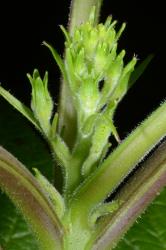- Taxon
- Gallery
- ≡ Colensoa physaloides (A.Cunn.) Hook.f., Bot. Antarct. Voy. II. (Fl. Nov.-Zel.) Part I, 157 (1853)
- ≡ Pratia physaloides (A.Cunn.) Hemsl. (1886)
- = Salvia koru R.Taylor bis, Te Ika a Maui 453 (1855)
Erect to spreading, branched herb or subshrub. Stems to c. 1 m tall, somewhat woody towards base. Petioles to 10 cm long. Lamina (5)–7–20–(22) × (3)–4–10–(13) cm, ovate or ovate-elliptic, occasionally elliptic, glabrous or puberulent on main veins, sometimes with scattered hairs elsewhere, coarsely and irregularly serrate-dentate, cuneate or attenuate at base, acute to shortly acuminate at apex. Infl. a terminal, few- to many-flowered raceme clothed in short hairs. Pedicels slender, 1.5–2.5 cm long; bracts often > 5 mm long, linear-subulate. Calyx lobes 5–8 mm long, narrow-triangular to linear-subulate. Corolla 3–5 cm long, usually pale to deep blue or violet, occasionally whitish, deeply lobed with lobes acute; lower lip 3-lobed, hairy; upper lip 2-lobed, the lobes c. 1.5–3.5 cm long and spreading. Fr. 10–15 mm diam., subglobose, blue or, less commonly, whitish.
[From: Webb et al. (1985) Flora of New Zealand. Volume 4 as Pratia physaloides (A.Cunn.) Hemsl.]




